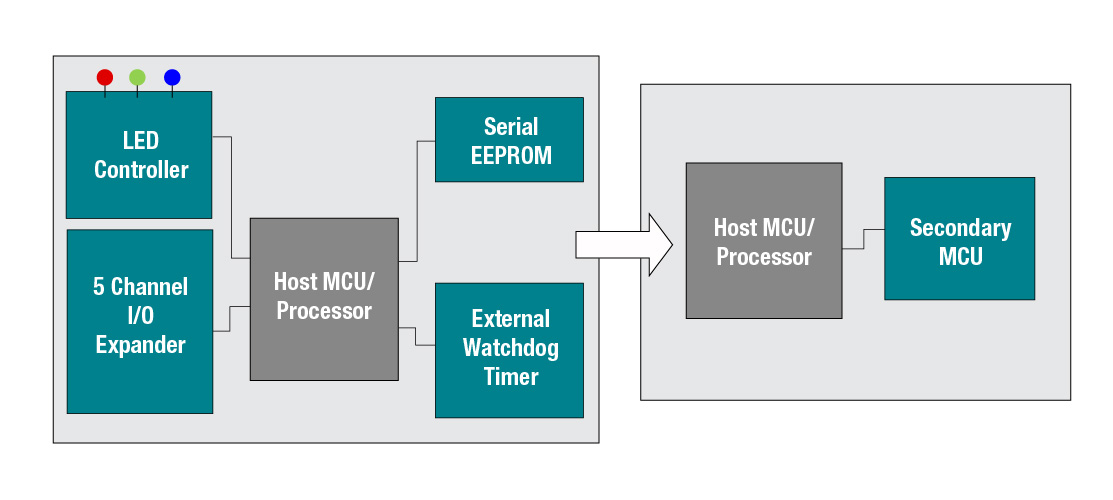SSZT248 october 2020 MSP430FR2000 , MSP430FR2100 , MSP430FR2110 , MSP430FR2111 , MSP430FR2422 , MSP430FR2433
You’re probably constantly looking for ways to optimize your printed circuit board (PCB) designs. From reducing board size to lowering costs and component count, maximizing efficiency is a requirement for almost any design.
Adding a small, low-cost microcontroller (MCU) for simple housekeeping functions can benefit many board designs. This housekeeping (or secondary) MCU is not the main host processor in the system, but it can handle several important system-level functions such as LED control or input/output (I/O) expansion. In this article, I’ll explain how integrating a multifunction housekeeping MCU in your system can help lower bill-of-materials (BOM) costs, save board space, and best of all simplify your design.
For example, let’s say that you wanted to create a new design with these features:
- LED control
- I/O expansion
- External electrically erasable programmable read-only memory (EEPROM)
- An external watchdog timer
It is possible to use discrete integrated circuits (ICs) to achieve each of these functions. Instead, consider performing all of the functions in software on a housekeeping MCU in order to minimize complexity and reduce board size, as shown in Figure 1.
 Figure 1 Implementing the functionality
of multiple discrete ICs and in software on a single housekeeping MSP430
MCU
Figure 1 Implementing the functionality
of multiple discrete ICs and in software on a single housekeeping MSP430
MCUAnother design challenge to consider – and perhaps one of the most important – is meeting your design budget.
For instance, looking at the costs associated with a discrete IC approach for these features, you could expect these approximate BOM costs (using web pricing):
- LED controller IC: approximately $0.20
- Five-channel I/O expander IC: approximately $0.25
- Serial EEPROM (4KB): approximately $0.20
- External watchdog timer: approximately $0.315
In total, a discrete approach to handle housekeeping functions would cost around $0.97. Compare that to the current web price for an 8KB MSP430 MCU, which is less than $0.25. That’s quite a large savings!
If you require more or less memory for your housekeeping MCU, you can find various options that scale across memory and price in the MSP430 MCU portfolio. Table 1 lists these MCUs and their current TI.com pricing.
| Memory | Product | Pricing |
|---|---|---|
| 0.5KB | MSP430FR2000 | See Pricing |
| 1KB | MSP430FR2100 | See Pricing |
| 2KB | MSP430FR2110 | See Pricing |
| 4KB | MSP430FR2111 | See Pricing |
| 8KB | MSP430FR2422 | See Pricing |
| 16KB | MSP430FR2433 | See Pricing |
Not only does an integrated housekeeping MCU approach save board size and reduce the number of components, it also saves BOM costs. You can learn more about these design considerations in the webinar, “Simpler system monitoring: How to offload multiple functions to an MSP430 MCU.”
Sample application: Implementing ADC wake and transmit functions on a housekeeping MCU
Let’s walk through an example of how to actually implement the housekeeping function within your design.
One common function is an analog-to-digital converter (ADC) interfacing with other devices on a board for applications such as battery monitors or temperature sensors. In this example, the ADC must periodically sample the analog signals from the sensors and send this data back to the MCU, which will take action based on the behavior of those signals.
If the MCU is using timers to trigger ADC reads, or even receiving ADC values continuously, the system can consume quite a bit of power. One solution is to integrate the ADC into the MCU and operate it independently of the central processing unit (CPU). That way, the rest of the MCU can go to sleep and will only wake up when the ADC reads a value that crosses a certain threshold. At this point, the ADC will generate an interrupt and wake up the MCU.
We describe this application in our training video about housekeeping functions, “ADC Wake and Transmit on Threshold Using MSP430 MCUs.” In this video, we show a graphical user interface (GUI) demonstrating the reading of the ADC values and the sending of the interrupt to wake up the CPU once the threshold is met.
Conclusion
Using another MCU to perform housekeeping functions is a great way to simplify your design. Plus, with our software and GUI, you can program your MSP430 device in minutes to handle a variety of functions.
Additional resources
- Learn more about the ADC wake and transmit function in the application note, “ADC Wake and Transmit on Threshold Using MSP430 MCUs"
- Try the ADC wake and transmit software example on an MSP430FR2433 LaunchPad™ development kit.
- Watch our training video “ADC Wake and Transmit on Threshold with a Housekeeping MCU”
- Download and test this example with the ADC Wake and Transmit demo GUI